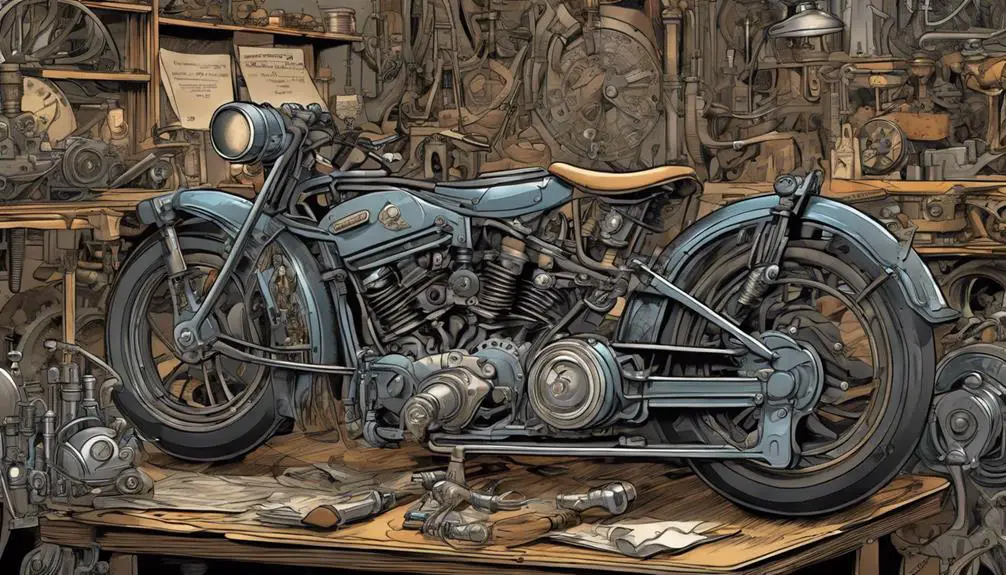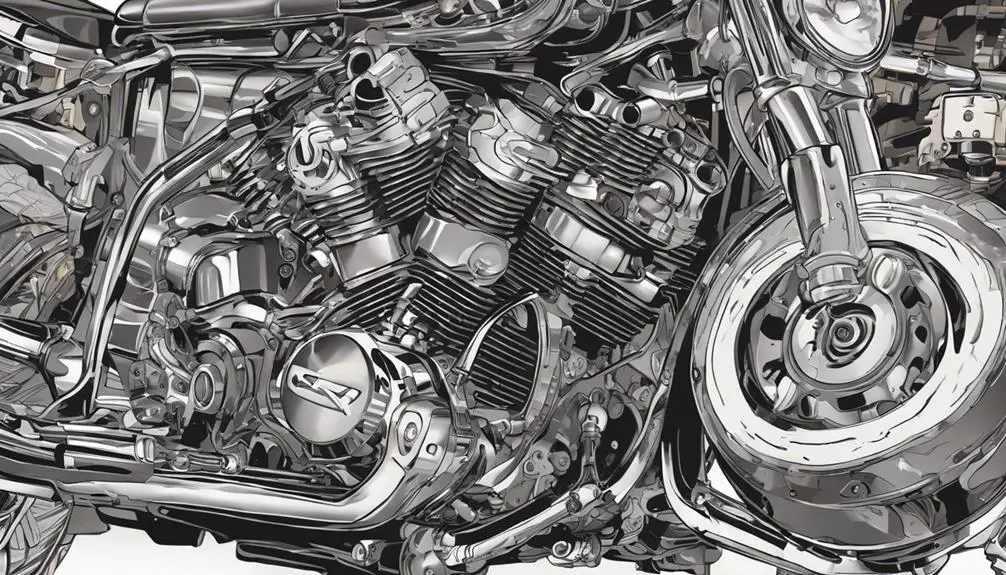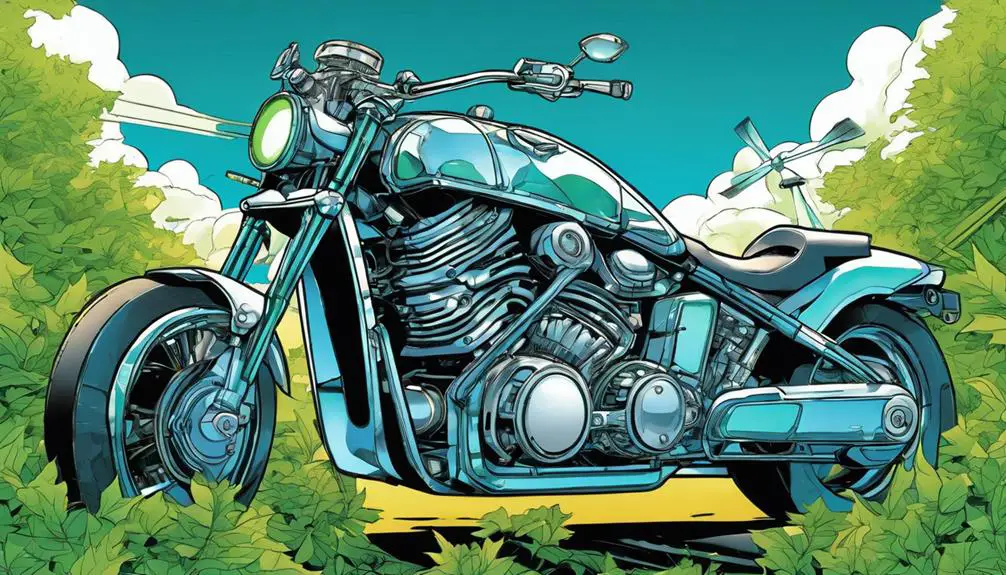When you think about the evolution of motorcycle engines, several pivotal milestones come to mind that have shaped the riding experience. You might recall how lightweight materials transformed speed and maneuverability, or how the two-stroke engine simplified maintenance for riders. Each of these innovations, from the introduction of water-cooled engines in the 1970s to the incredible acceleration of the T500, played a significant role in defining modern motorcycles. But what about the more recent advancements, like the Hayabusa and eco-friendly technologies? These developments signal a shift in both performance and sustainability, and they raise important questions about the future of motorcycle engineering.
Quick Takeaways
- Introduction of two-stroke engines simplified maintenance and boosted power, marking a significant advancement in motorcycle engine design.
- The transition to water-cooled engines in the 1970s enhanced performance, longevity, and reliability for diverse riding conditions.
- Development of fuel injection technology replaced carburetors, improving efficiency, throttle response, and overall riding experience.
- The launch of models like the T500 showcased lightweight frames and powerful engines, redefining motorcycle performance and handling.
Early Innovations in Engine Design

In the early days of motorcycle development, innovators pushed boundaries by experimenting with lightweight materials and efficient engine designs. You can sense the thrill in the air as these pioneers sought to break free from conventional limitations. They understood that a lighter bike meant more speed and agility, allowing riders like you to roam freely on the open road.
Early engines, often single-cylinder or V-twin designs, featured innovative features such as overhead valves and better fuel efficiency. This wasn't just about mechanics; it was about liberation. With every advancement, you could feel the spirit of adventure growing stronger.
The introduction of two-stroke engines brought a new level of simplicity and power, making it easier for you to hit the road without the burden of complex maintenance. These innovations laid the groundwork for the motorcycles that are recognized today. They ignited a passion for freedom, encouraging more riders to join the movement.
As you rev your engine, remember that every twist of the throttle is a nod to those early visionaries who dared to dream. Embrace that spirit and let your journey unfold.
The Launch of the T500
The launch of the T500 marked a significant leap in motorcycle engine technology, offering riders a powerful yet manageable option for their adventures. With its innovative design and robust performance, it opened up a world of freedom on two wheels. You could feel the thrill of the open road and the wind in your face as you navigated through city streets or took on winding country lanes.
The T500 featured:
- A lightweight frame for nimble handling
- A 493cc two-stroke engine for impressive acceleration
- A reliable power band, perfect for both novices and seasoned riders
This motorcycle didn't just deliver power; it embodied the spirit of liberation, allowing you to explore without limits. Riders appreciated the balance of speed and control, making every journey feel like an adventure waiting to unfold.
As you hopped on the T500, you'd realize that it wasn't just about getting from point A to point B; it was about embracing the ride and experiencing the thrill of life on two wheels. The T500 truly redefined what it meant to be free on a motorcycle.
Advancements With the GS Series

The GS Series has transformed motorcycle engine design with its innovative features that push the boundaries of performance.
You'll notice how these advancements haven't only enhanced speed but also improved overall efficiency.
Let's explore how these developments have set new standards in the motorcycle industry.
Innovations in Engine Design
Motorcycle enthusiasts have seen remarkable innovations in engine design with the advancements of the GS Series, pushing performance and efficiency to new heights. These developments not only enhance your riding experience but also enable you to connect more deeply with the road. The GS Series has redefined what's possible, and you'll appreciate the thoughtful engineering behind it.
Key innovations include:
- Liquid Cooling: Maintaining ideal engine temperature for consistent performance.
- Counterbalancer Systems: Reducing vibrations for a smoother ride.
- Advanced Fuel Injection: Ensuring precise fuel delivery for improved responsiveness and efficiency.
These features signal a shift towards more rider-centric designs, allowing you to enjoy longer rides without sacrificing comfort or power.
With every twist of the throttle, you'll feel the culmination of decades of engineering wisdom, combined with cutting-edge technology. The GS Series isn't just about performance; it's about giving you the freedom to explore and enjoy the journey, making every ride an exhilarating adventure.
Embrace these innovations and release your spirit of adventure like never before!
Enhanced Performance Features
Harnessing cutting-edge technology, the GS Series boasts enhanced performance features that elevate your riding experience to a whole new level.
You'll feel the difference as you twist the throttle, thanks to the advanced engine management systems that optimize power delivery and fuel efficiency. The GS Series utilizes a lightweight frame and cutting-edge suspension, allowing you to carve through curves with exhilarating precision.
With features like ride modes and traction control, you can customize your ride according to your desires and the terrain ahead. Whether you're cruising on the open highway or tackling rugged trails, the GS Series adapts to your needs, giving you the freedom to explore without limits.
The high-performance braking system offers confidence-inspiring stopping power, ensuring you can handle any situation with ease. You'll discover an intuitive dashboard that keeps you informed, allowing you to focus on the thrill of the ride.
In the GS Series, enhanced performance features aren't just about speed; they're about liberation. You're not just riding a motorcycle; you're embracing an adventure that invites you to break free and discover the world on your terms.
Introduction of the Water-Cooled Engine
When you think about motorcycle engines, water-cooling stands out as a game changer.
It offers significant benefits, like improved performance and reliability, compared to traditional air-cooled systems.
Let's explore the key historical developments that brought water-cooled engines into the spotlight.
Benefits of Water-Cooling
Water-cooled engines consistently offer superior temperature regulation, allowing for excellent performance and longevity in a variety of riding conditions. By maintaining ideal engine temperatures, you can unleash the full capabilities of your motorcycle, making every ride a thrilling experience.
Here are some key benefits of water-cooling:
- Enhanced Performance: Water-cooled engines run cooler, which helps prevent overheating and maintains horsepower throughout your journey.
- Longer Lifespan: Consistent temperature control reduces wear and tear on engine components, extending the overall lifespan of your bike.
- Reduced Emissions: With better combustion efficiency from stable temperatures, you'll contribute to a cleaner environment while enjoying the freedom of the open road.
Key Historical Developments
The introduction of water-cooled engines marked a significant advancement in motorcycle technology, revolutionizing performance and reliability for riders everywhere. You may remember the days when air-cooled engines struggled to maintain ideal temperatures, especially during long rides or in heavy traffic. With the advent of water-cooling, engineers created a system that efficiently managed heat, allowing your motorcycle to run smoother and last longer.
Water-cooled engines first gained traction in the 1970s, offering radical improvements over their predecessors. The closed-loop cooling system meant that you could push your limits without constantly worrying about overheating. As a result, manufacturers began designing bikes that embraced this technology, leading to more powerful engines and enhanced handling.
This shift empowered you as a rider, providing the freedom to explore new terrains without the fear of engine failure. Not only did water-cooled engines boost performance, but they also contributed to quieter rides and improved fuel efficiency.
Today, you enjoy the fruits of this evolution, as most modern motorcycles feature water-cooling systems. So, embrace the thrill of the open road, knowing that your ride is backed by cutting-edge technology that prioritizes your freedom and adventure.
The Revolution of the Hayabusa

Suzuki's Hayabusa redefined speed and performance in the motorcycle world, enchanting enthusiasts and pushing engineering boundaries. When it hit the market in 1999, it didn't just claim the title of the fastest production motorcycle; it released a new era of raw power and aerodynamic design. You felt the thrill as the Hayabusa roared to life, inviting you to explore its capabilities.
What made the Hayabusa revolutionary? Here are some standout features:
- Aerodynamic Design: Its sleek, wind-cutting body shape minimized drag, allowing for astonishing top speeds.
- Powerful Engine: The 1,298cc inline-four engine delivered heart-pounding acceleration, making every ride an adrenaline rush.
- Advanced Suspension: The fully adjustable suspension provided superior handling, enabling you to tackle curves with confidence.
With the Hayabusa, you weren't just riding a motorcycle; you were breaking the barriers of speed and experiencing liberation on two wheels. This machine continues to inspire a passion for performance, urging riders to release their inner thrill-seekers.
Development of Fuel Injection Technology
Fuel injection technology revolutionized motorcycle performance by replacing traditional carburetors, allowing for more precise fuel delivery and improved efficiency. You'll appreciate how this change enhances your ride, giving you the freedom to enjoy a smoother throttle response and better acceleration. With fuel injection, motorcycles can adapt to various conditions, adjusting the air-fuel mixture on the fly, ensuring peak performance no matter where you roam.
Gone are the days of fiddling with jets and tuning carbs. Fuel injection systems self-regulate, which means you can focus on the thrill of the ride without constant maintenance. You'll also find that fuel efficiency increases, allowing you to venture further on each tank, embracing the open road with less worry about refueling.
Moreover, fuel injection promotes a cleaner burn, translating to better power output and less wasted energy. This technology empowers you to release your bike's full potential, delivering exhilarating performance while minimizing hassle.
In this era of motorcycle development, fuel injection stands as a proof of innovation, enabling you to experience the ultimate liberation on two wheels. Get ready to ride like never before!
Embracing Eco-Friendly Technologies

Embracing eco-friendly technologies in motorcycle design not only reduces your carbon footprint but also enhances your riding experience.
You'll find that going green doesn't mean sacrificing power or performance; instead, it opens up a world of possibilities. By opting for sustainable innovations, you can enjoy the thrill of the ride while caring for the planet.
Consider these eco-friendly options available to you:
- Electric Motors: Experience instant torque and a silent ride without emissions.
- Alternative Fuels: Explore biofuels and hydrogen as potential energy sources that offer cleaner combustion.
- Lightweight Materials: Utilize materials like carbon fiber or aluminum to reduce weight, which improves efficiency.
As you embrace these advancements, you'll not only become part of a movement toward a sustainable future but also enjoy the freedom that comes with innovative engineering.
Your choice to ride eco-friendly can inspire others, creating a ripple effect that promotes a cleaner, greener world.
Common Questions
What Are the Key Differences Between Two-Stroke and Four-Stroke Engines?
When you compare two-stroke and four-stroke engines, you'll notice key differences.
Two-stroke engines deliver power every revolution, making them lighter and simpler, but they're less fuel-efficient and produce more emissions.
On the other hand, four-stroke engines generate power every other revolution, offering better fuel efficiency and lower emissions, but they're heavier and more complex.
Each has its own advantages, so it's about what fits your riding style and freedom needs best.
How Has Motorcycle Engine Design Influenced Automotive Engines?
Picture the roar of a motorcycle engine slicing through the wind—it's a sound that ignites a sense of freedom.
Motorcycle engine design has influenced automotive engines by pushing boundaries in power, efficiency, and weight reduction.
You've seen how innovations like fuel injection and lightweight materials in bikes trickle down to cars, creating faster, more agile vehicles.
This spirit of liberation drives engineers to continuously evolve, making both motorcycles and cars more exhilarating.
What Role Do Racing Competitions Play in Engine Development?
Racing competitions drive innovation in engine development by pushing manufacturers to maximize performance.
You'll see engineers fine-tuning designs, experimenting with materials, and developing advanced technologies to gain an edge.
This quest for speed and efficiency leads to breakthroughs that often trickle down into consumer models.
When you watch a race, you're witnessing the culmination of passion, competition, and the relentless pursuit of engineering excellence that shapes the future of all engines.
Are There Any Significant Safety Advancements in Motorcycle Engines?
Did you know that motorcycle accidents have dropped by over 30% since new safety advancements were introduced?
You're riding in an age where manufacturers are prioritizing your safety. Innovations like anti-lock braking systems (ABS) and traction control have become standard, helping you maintain control in tricky conditions.
Plus, engine designs are now built with better impact absorption, ensuring you have a safer, more liberated riding experience.
Embrace the thrill with peace of mind!
How Have Consumer Preferences Shaped Motorcycle Engine Innovations?
Consumer preferences have driven motorcycle engine innovations by pushing manufacturers to prioritize performance, efficiency, and sustainability.
You've likely noticed how riders now demand lightweight designs and enhanced fuel economy.
As you embrace freedom on the road, companies respond with cutting-edge technology, like electric engines and advanced materials.
These trends reflect your desire for not just speed, but also responsibility towards the environment, shaping a new era of thrilling yet eco-friendly riding experiences.
Wrapping Up
In the grand tapestry of motorcycle history, these milestones are like roaring thunderclaps that echo through time.
You've witnessed the evolution from clunky engines to lightning-fast machines that scream down the highway, defying gravity and convention.
As you rev your engine, feel the pulse of innovation beneath you—it's not just a ride; it's a wild dance with destiny.
So gear up, embrace the thrill, and let the spirit of these breakthroughs propel you into the future of biking!